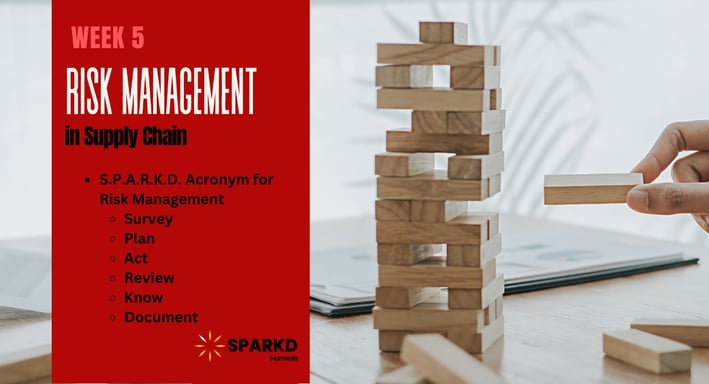Week 5: Supply Chain Risk Management
Effective supply chain risk management is critical for organizations to mitigate potential disruptions, minimize impact, build resilience, and maintain business continuity, ultimately helping them thrive in today's rapidly changing business environment. We introduce the SPARKD risk management acronym, which provides a framework for organizations to develop a comprehensive and proactive risk management plan.


Supply chain risk management is an essential process that organizations must adopt to ensure they can navigate potential disruptions to their supply chain. In Week 5 of our training, we focused on understanding supply chain risk management and the strategies that organizations can employ to mitigate risks.
Survey: Identify Potential Risks
The first step in effective supply chain risk management is surveying the risks. This involves identifying potential risks to your supply chain, including natural disasters, supplier bankruptcy, political instability, cyber attacks, and more.
To effectively survey the risks, organizations can conduct a comprehensive risk assessment that evaluates all areas of the supply chain, including suppliers, transportation, production, and distribution. Once identified, organizations can prioritize the risks based on their potential impact and likelihood of occurring, allowing them to focus their efforts on the most critical risks.
Plan: Develop a Comprehensive Risk Management Plan
After identifying the risks, the next step is to develop a plan to mitigate them. Organizations can start by creating a risk management plan that outlines the strategies they will employ to reduce the risks identified in the survey phase.
This plan should include contingency plans, diversifying suppliers, investing in risk management tools, and other proactive measures. It's crucial to involve all stakeholders, including suppliers and customers, in the planning phase to ensure that the plan is effective and feasible.
Act: Implement the Risk Management Plan
The third step is to take action on the risk management plan. You’ve constructed a plan, now implement the strategies outlined in the plan. Continually monitor the supply chain for potential risks.
For example, if the plan includes diversifying suppliers, the organization can start by identifying alternative suppliers and establishing relationships with them. They can also invest in risk management tools to monitor the supply chain for potential disruptions, such as early warning systems and predictive analytics. It's essential to continually monitor the effectiveness of the strategies and adjust them as needed.
Review: Evaluate the Effectiveness of the Risk Management Plan
The fourth step is to review the risk management strategies regularly. This involves assessing the effectiveness of the strategies employed and identifying any gaps or areas for improvement. Organizations can conduct periodic risk assessments to evaluate the effectiveness of the risk management plan and identify new or emerging risks. They can also review the performance of suppliers and other stakeholders regularly to ensure that they are meeting the organization's standards.
Know: Stay Informed about Industry Trends and Emerging Risks
Knowledge is power. The fifth step is to stay informed and knowledgeable about the risks facing the organization's supply chain. This involves staying up to date with industry trends and changes that may impact the supply chain, such as changes in regulations, new technology, or shifts in the market.
Invest in training and education for employees and stakeholders to ensure that they have the knowledge and skills necessary to effectively manage supply chain risks. By investing time and resources into training and gathering information, organizations are more prepared to make informed decisions when developing and implementing their risk management strategies.
Document: Document the Risk Management Plan
Documentation is crucial in ensuring that the risk management plan is consistently followed and updated. The plan should be well-documented, and all team members should have access to it. Additionally, documentation can help facilitate communication and collaboration with stakeholders, including suppliers, customers, and regulatory bodies.
To effectively document their risk management processes, organizations should establish clear guidelines and templates for documentation, ensure that all stakeholders are trained on these guidelines, and regularly review and update documentation as needed.
Bonus: Regularly Review and Update the Risk Management Plan
As we wrap up this week's post, it's essential for organizations to continually review and update their risk management strategies. This is because supply chain risks are constantly evolving, and what's working today may not work tomorrow. By staying ahead of the risks and implementing proactive measures, organizations can build resilience and protect their supply chain from potential disruptions. Regularly reviewing and updating the risk management plan is crucial in ensuring that it remains effective and up-to-date.
Effective supply chain risk management is crucial in mitigating potential disruptions to the supply chain. The SPARKD risk management acronym provides a framework for organizations to develop a comprehensive and proactive risk management plan. By identifying potential risks, developing a risk management plan, implementing the plan, evaluating its effectiveness, staying informed about industry trends, documenting the plan, and regularly reviewing and updating it, organizations can build resilience and protect their supply chain from potential disruptions.
Supply Chain Risk Management
Survey:
Identify potential risks to the supply chain, including natural disasters, supplier bankruptcy, political instability, cyber attacks, etc.
Plan:
Create a risk management plan that outlines strategies to reduce identified risks
Act:
Take action on the risk management plan by implementing the strategies outlined in the plan
Review:
Review risk management strategies regularly to assess effectiveness
Know:
Stay up to date with industry trends and changes that may impact the supply chain
Document:
Ensure the risk management plan is well-documented and accessible to all team members
Change isn't always a bad thing. Use it to your advantage. How? Read our post on Navigating Change.
Prefer to read it all in one go as a PDF? Get the 7-Step Supply Chain Crash Course here.


